| |
|
Xiamen Oil Paintings, Wholesale Direct!
|
|
100% hand painted, 100% cotton canvas, 100% money back if not satisfaction. |
|
|
|
|
ART WORKS INDEX
A
B
C
D
E
F
G
H
I
J
K
L
M
N
O
P
Q
R
S
T
U
V
W
X
Y
Z
|
|
ARTISTS INDEX
A
B
C
D
E
F
G
H
I
J
K
L
M
N
O
P
Q
R
S
T
U
V
W
X
Y
Z
|
|
|
|
|
|
|
|
|
|
|
|
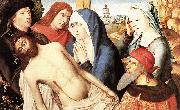 |
Master of the Legend of St. Lucy
|
|
(fl. 1480-1510) was an unidentified Early Netherlandish painter who worked in Bruges, now a city in Belgium. His name comes from for an altarpiece in the church of Saint James in Bruges, which is dated 1480 and depicts three scenes from the life of Saint Lucy. Since then, twenty-five to thirty-five paintings have been attributed to the same hand. He may have trained Spanish students at his studio in Bruges. Many of them are characterized by views of the city of Bruges in the background, and can be dated according to the level of construction of its belfry. He may have trained with Dieric Bouts, and was certainly influenced by Bruges' greatest artist at the time, Hans Memling.
|
|
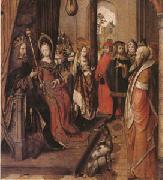 |
Master of the Legend
|
|
active in Cologne ca 1490/1500
Austrian painter and woodcutter. He is named after two altarpiece wings with three scenes from the Legend of SS Cosmas and Damian: the Miraculous Healing of the Leg, A Husband Commending his Wife to the Saints and the Delivery of the False Message by the Devil (Vienna, Ksthist. Mus.). He is thought to have been the earliest disciple of Lucas Cranach the elder in Austria and to have been later influenced by both Albrecht Altdorfer and J?rg Breu the elder. His rather stately figures are in splayed-out, often affected poses, with the feet and knees twisted outwards, appearing almost dislocated.
|
|
|
|
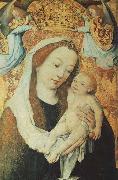 |
Master of the Housebook
|
|
German Northern Renaissance Painter, 15th Century, German graphic artist. The master is named for a series of vigorous and sophisticated drawings of everyday life found in the Hausbuch at Castle Wolfegg. Many of his engravings are in the Rijksmuseum, Amsterdam. His work is thought to have influenced Bosch, Bruegel, and Durer.
|
|
|
|
|
|
|
|
|
|
|
|
|
|
|
|
|
|
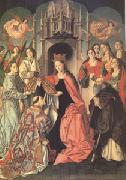 |
Master of ST Ildefonso
|
|
Castile,end of the fifteenth century
Spanish painter. He is named from St Ildefonso's Reception of a Chasuble from the Virgin Mary (Paris, Louvre), which is traditionally held to come from Valladolid; it may even have come from the chapel of S Ildefonso in the Colegiata there. The style, characterized by harmony of colour and intense expressions, resembles that of four panels of St Athanasius, St Louis of Toulouse, both enthroned, SS Peter and Paul and SS Andrew and James the Great, which probably came from the convent of La Merced, Valladolid. They have been attributed to the Master of vila, but Post considered them to be the work of the Master of St Ildefonso, a more sophisticated painter, although both artists modified the harshness of their Netherlandish models. There are also similarities with Jacomart's triptych of St Anne in the Colegiata, Jetiva, but these may be coincidental. Other works attributed to the Master include St Anne and St Anthony of Padua,
|
|
|
|
|
|
|
|
|
|
|
|
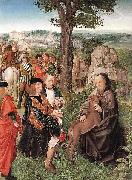 |
Master of Saint Giles
|
|
The Master of Saint Giles (French: Maître de Saint-Gilles) was a Franco-Flemish painter active, probably in Paris, about 1500, working in a delicate Late Gothic manner, with rendering of textures and light and faithful depictions of actual interiors that show his affinities with Netherlandish painting. It is not clear whether the Master of Saint Giles was a French painter who trained in the Low Countries (perhaps more likely), or a Netherlander who emigrated to France.
His pseudonym was given him by Max Friedländer, who reconstructed part of the anonymous painter's oeuvre, starting from two panels devoted to Saint Giles (a Miracle and a Mass) in the National Gallery, London, that were part of the lefthand shutter of an altarpiece, and two further panels now in Washington from the same altarpiece. The hand of an assistant can be discerned in the Baptism of Clovis at the National Gallery of Art, Washington, who also have a panel with Episodes from the Life of a Bishop-Saint - perhaps Saint Leu, Saint Denis or Saint Remy. All four panels have, or had, single grisaille figures of saints (Saints Peter, Giles, Denis and an unidentified bishop-saint) in niches, imitating sculpture, on the reverse. The Washington pair, which were in poor condition, have been separated and are lost, although photographs exist. Undoubtedly there were further panels, whose subjects cannot be guessed, as the combination of scenes is original.
|
|
|
|
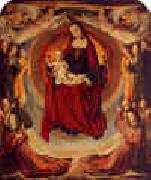 |
Master of Moulins
|
|
French
1480-1500 Master of Moulins Gallery
Until the late 20th century, the name of the painter of the Moulins Triptych was unknown, although art historians identified a number of other works that were evidently by the same hand. The first monograph on the Master of Moulins, written in 1961 by Madeleine Huillet d'Istria, argued that this artist did not actually exist, and that more than 12 different artists were responsible for the corpus of works traditionally ascribed to him. The Master's identity was established after an inscription was found on the reverse of a damaged painting, Christ with Crown of Thorns (1494) in the Royal Museums of Fine Arts of Belgium, Brussels, identifying the artist as Jean Hey, teutonicus and pictor egregius ("the famous painter"), and identifying the patron as Jean Cueillette, who was secretary to the King and an associate of the Bourbon family. Stylistic similarities link this painting to the works attributed to the Master of Moulins. The Master of Moulins appears to have been the court painter for the Bourbons, and from a surviving account for 1502-03, it is clear that the court painter's name was Jean; other candidates once considered plausible, such as Jean Perr??al and Jean Prevost, have proven untenable in the light of subsequent research. The term "Teutonicus", or "German" included Flemings at this date.
|
|
|
|
|
|
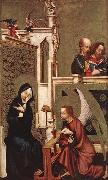 |
MASTER of Heiligenkreuz
|
|
Austrian Northern Renaissance Painter, 15th Century,was an Austrian painter active at the beginning of the fifteenth century; a tentative lifespan of 1395 to 1430 has been put forth, but this appears highly conjectural. His name is taken from a diptych that once belonged to the Cistercian Abbey of Heiligenkreuz, located in southeastern Austria near the present-day border with Hungary. The left panel depicts the Annunciation on the obverse; the reverse is a depiction of the Madonna and Child. The right panel depicts the Mystical Marriage of Saint Catherine, with Saint Dorothy on its reverse. Details of costume and iconography combine with associations with the International Style to indicate a date of around the first decade of the fifteenth century.
It was initially proposed, by Betty Kurth in 1922, that the artist was French and had some association with the court in Paris. Other writers have disagreed, and various nationalities including French, Austrian, German, or Bohemian have been posited for the Master. Some have further suggested that he was an itinerant court artist, trained in France but active in Austria. Various clues have been used in an attempt to describe his nationality. These include his use of finely-worked gold decoration, in which some have seen a link to Franco-Burgundian goldsmith's work of the late fourteenth century. Others, instead, see it as a link to the school of panel painting then active at the court in Prague. Consequently, it seems highly unlikely that the artist's nationality will be conclusively established.
|
|
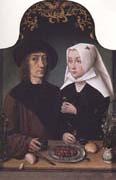 |
Master of Frankfurt
|
|
Flemish Northern Renaissance Painter, 1460-ca.1533.South Netherlandish painter. He takes his name from two paintings commissioned by patrons from Frankfurt am Main. His chief importance lies in his continuing the great tradition of 15th-century Netherlandish painting (particularly the compositions of Rogier van der Weyden and Hugo van der Goes) well into the 16th century, his development of a markedly earthy figure type, his apparently innovative management of a large workshop that 'mass-produced' paintings for the open market and his status
|
|
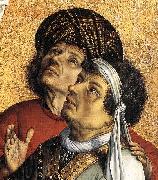 |
Master Of Flemalle
|
|
Robert Campin (c. 1375 - 26 April 1444), now usually identified as the artist known as the Master of Flemalle, is usually considered the first great master of Flemish and Early Netherlandish painting. This had been a matter of controversy for decades; Campin's life is relatively well documented for the period, but no works in assessable condition could be securely connected with him, whilst a corpus of work had been attached to the unidentified "Master of Flemalle", named after the supposed origin of a work.
Campin seems to have had relatives in Valenciennes. He first appears as settled in Tournai from the archives of 1405-6, as a free master of the guild of painters, and he bought citizenship in 1410, which suggests he was not born there. He eventually attained the office of dean of the guild, and wardenship of a church and other civic offices, and was running a large workshop. By 1432, however, he lost his civic positions because of scandals, and probably his role in political disturbances in the city. In 1429 he was found guilty of withholding evidence, and sentenced to go on a pilgrimage, and in 1432 was convicted of adultery and banished for a year. Margaret of Burgundy, wife of the Count of Holland and sister of John the Fearless, Duke of Burgundy intervened on his behalf, and this was reduced to a fine. The dated Werl Altarpiece (1438) shows he continued to work (the two outer wings are in the Prado; the main panel is lost).
|
|
|
|
|
|
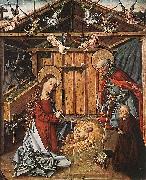 |
Master of Avila
|
|
15 Master of Avila Nativity 1474-76 Oil on wood Museo Lezaro Galdiano, Madrid This is the finest work of the master, it forms part of a triptych as the central panel. The left panel was the Annunciation to the Shepherds while the right panel represented the Annunciation to the Magi. The composition follows the example of Gallego's paintings and the use of the cool colors
|
|
|
|
|
|
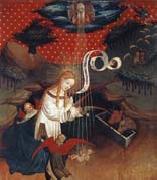 |
Master Francke
|
|
German painter (early 15th century, active in Hamburg). respectively German for "Master Francke" and Latin for "Brother Francke", was a North German Gothic painter and Dominican friar, born ca. 1380 in the Lower Rhine region or possibly Zutphen in the Netherlands, who died ca. 1440, probably in Hamburg, where he was based at the end of his known career. He is called "Fratre Francone Zutphanico" ("Brother Frank of Zutphen") in one document. He may have trained as an illuminator and painter in France or the Netherlands, and later worked in Munster, before joining in St John's Friary in Hamburg by 1424 at the latest.
Two main altarpieces attributed to him survive, dedicated to St Thomas of Canterbury and Saint Barbara, in an unusually intense style, showing awareness of French and Early Netherlandish court art. He probably arrived in Hamburg after the death in 1415 of the previous leading artist there, Master Bertram, and shows little or no influence from him, but he may have been influenced by the more courtly style of Conrad von Soest, about ten years older than Francke, who worked to the south in Westphalia.
The Hamburg association of traders to England commissioned an altarpiece from "Mester Francke[nn]" in 1424; the contract does not survive, but is mentioned in their memorial book. This is probably the "St Thomas (of Canterbury) Altarpiece", completed in 1436, of which parts survive in the Kunsthalle, Hamburg. The rather earlier St Barbara Altarpiece may have been commissioned for Finland, where it surfaced a century ago. The "Thomas Altar" has eight surviving scenes, but is missing its main panel and several others. The "Barbara Altar" has also eight scenes, on both sides of the wings to a carved wood central panel by another artist. At least two other panels are in museum collections. Francke was almost entirely forgotten after the Renaissance until the end of the 19th century when, like Master Bertram, he was rediscovered and published by Alfred Lichtwart, Director of the Hamburg Kunsthalle
|
|
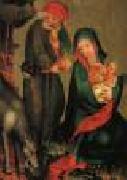 |
MASTER Bertram
|
|
German painter (b. cca. 1345, Minden, d. 1415, Hamburg).
was a German International Gothic painter primarily of religious art. His most famous surviving work is the large Grabow Altarpiece (or Petri-Altar) in the Kunsthalle Hamburg, the largest and most important North German painting of the period. There is a 45-scene altarpiece of the Apocalypse, probably by his workshop, in the Victoria and Albert Museum in London. He, or his workshop, also produced sculpture, presumably in wood; in fact in his first years in Hamburg most surviving documentation relates to sculpture, including chandeliers. He is first recorded in Hamburg in 1367, and lived there for the rest of his life, becoming a citizen and Master in 1376, and achieving considerable prosperity. In 1390 he made a will in advance of an intended pilgrimage to Rome, but if he made the journey it had no detectable influence on his art. He was married, but his wife had died by his second will in 1410, when he had a surviving daughter. His style is less emotional than that of his Hamburg near-contemporary Master Francke, but has great charm. Bertram was largely forgotten after the Renaissance until the end of the 19th century
|
|
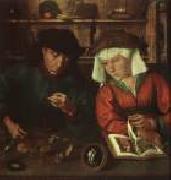 |
MASSYS, Quentin
|
|
Flemish Northern Renaissance Painter, ca.1465-1530
Quentin Massys, also spelled Matsys or Metsys, was born in Louvain, the son of a blacksmith. He is traditionally thought to have been trained in that craft by his father. Art in Louvain while Massys was growing up was dominated by Dirk Bouts. Massys became a member of the painters' guild in Antwerp in 1491 and died there in 1530. He represented a current of painting that flourished in Antwerp at this time of its sudden new prosperity. Erwin Panofsky (1953) described this trend, "archaism of around 1500," as "a prelude to, in fact a fact of, the Renaissance in Netherlandish painting," which prevailed in the southern Netherlands. The monumental Enthroned Madonna (Brussels), an early work by Massys, has features recalling both Robert Campin and Jan van Eyck. The central panel of Massys' imposing St. Anne Altarpiece, or the Holy Kinship (Brussels), which was commissioned for the church of St-Pierre in Louvain in 1507 and signed and dated 1509, has a prototype in the Holy Kinship of Geertgen tot Sint Jans. Even the physical types and costumes in Massys' version refer to Geertgen's. But Massys placed his rhythmically balanced figure groups in a domed, arcaded loggia that in architectural style appears to be reaching for a Renaissance vocabulary it cannot quite attain; certainly the architecture evokes a later period than that represented by the Gothic throne of the Enthroned Madonna. The calm and restraint of the St. Anne Altarpiece are replaced by heightened emotional expression in the next important painting by Massys that can be firmly dated, the Deposition triptych (Antwerp). This was commissioned in 1508 by the guild of joiners in Antwerp for their chapel in the Cathedral; Massys completed the composition in 1511. It was inspired by Rogier van der Weyden's great Deposition, which was in the church of St-Pierre in Louvain in Massys' time, and also quotes from Rogier's Entombment. Massys painted genre subjects, possibly with emblematic meaning, such as A Money Changer and His Wife, which belonged to a Netherlandish tradition that maintained its popularity right through the 17th century. In portraiture he made significant contributions. His pair of portraits of Erasmus and Petrus Aegidius, painted in 1517 for Sir Thomas More, set the pattern for representations of the scholar in his study.
|
|
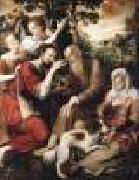 |
MASSYS, Jan
|
|
Netherlandish Painter, ca.1509-1575
Painter, son of Quinten Metsys. More so than his brother Cornelis Massys, who was a less talented artist, Jan worked in the style of his father, whose studio he may have taken over following his death in 1530. Two years later, though still under the age of majority, Jan was admitted as a master in the Guild of St Luke in Antwerp. Like Cornelis, he seems to have left Antwerp immediately after attaining the status of master, for he is not mentioned again in the archives. It has been suggested on stylistic grounds that he worked for a period at Fontainebleau, but this is disputed. He was, in any case, back in Antwerp by 1536, when he took on an apprentice, Frans van Tuylt. In 1538 he married Anna van Tuylt, by whom he had three children.
|
|
|
|
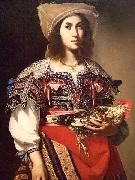 |
Massimo Stanzione
|
|
(also called Stanzioni; c. 1586 - c. 1656) was an Italian Baroque painter, mainly active in Naples.
Massimo Stanzione was an Italian Baroque painter. Born in Naples in 1586, Massimo was greatly influenced by Michelangelo Merisi da Caravaggio, but what earned him the nickname of The Neapolitan Guido Reni was his sophisticated and graceful style. The thing that distinguished Massimo art from Carravaggism was that he combined Caravaggio dramatically lit and brutally realistic style with the classical and lyrical manner of Bolognesi painters.
Though his preliminary training is uncertain, it is thought that he studied with Fabrizio Santafede; however, most of the influence he received was from Caravaggio. Art historians believe that Stanzione developed his career as an artist in Rome. It is thought that he bagan his career as a portraitist. Some of his most famous works include Portrait of a Woman in Popular Costume, and Portrait of Jerome Banks. Between 1617 and 1630, it is believed that he traveled between the papal city and his hometown of Naples exploring different styles of art. Also influenced by Caravaggio were Artemisia Gentileschi, Simon Vouet, and Carlo Saraceni. During Stanzione career a movement that changed the style of art was formed. Stanzione was a part of this movement. This movement transformed the dark, contrasted Caravaggio-styled art into Bolognese colorism and soft art.
|
|
|
|
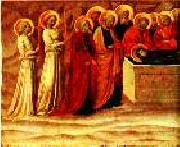 |
MASOLINO da Panicale
|
|
Italian Early Renaissance Painter, ca.1383-1447
Florentine painter of the early Renaissance, whose real name was Tommaso di Cristoforo Fini. His versatile painting incorporated his feeling for decorative color with strong modeling and spatial organization. He was admitted (1423) to the apothecaries' guild in Florence, in which painters were enrolled, and was soon commissioned to paint the frescoes in the Brancacci Chapel in Florence. These were continued by his pupil Masaccio upon Masolino's departure (1427) for Hungary and were completed by Filippino Lippi, thus greatly complicating the question of authorship; currently scholars attribute to Masolino St. Peter Preaching, St. Peter Healing the Cripple, The Raising of Tabitha, and The Fall of Adam and Eve. Upon his return to Florence, Masolino found painters occupied with problems of perspective, light and shade, and classical architecture and decoration, ideas that he utilized while retaining much of the old Giottesque tradition. He went to Rome where he painted frescoes in the Church of San Clemente for the Cardinal Branda Castiglione. For the same patron he decorated the church of Castiglione di Olona in the province of Como, Italy. There he represented scenes from the life of the Virgin and of St. John the Baptist. Attributed to Masolino are The Foundation of Santa Maria Maggiore and a Madonna and Christ in Glory (Naples);
|
|
 |
Masolino
|
|
Italian
c1383-c1477
Masolino Gallery
The principal monograph is by Toesca, Masolino da Panicale (Bergamo, 1908); also, A. H. Layard, The Brancacci Chapel and Masolino, Masaccio, and Filippino Lippi published by the Arundel Society (London, 1868); Schmarsow, Massacio Studien (Cassel, 1895-1900); Bernard Berenson, "Quelques peinures m??connues de Masolino da Panicale," in Gazette des Beaux-Arts, ser. 3, volume xxvii (Paris, 1902); Berenson in Study and Criticism of Italian Art, volume ii (London, 1902); Crowe and Cavalcaselle, History of Painting in Italy, edited by Douglas and Strong (New York, 1903); for data on the life of Masolino: Milanesi, Storia dell' arte toscana (Florence, 1873).
|
|
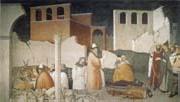 |
Maso di Banco
|
|
Italian Early Renaissance Painter, active 1320-1350
|
|
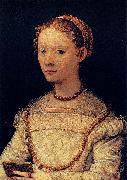 |
Maso da San Friano
|
|
(1536-1571) was an Italian painter active in Florence. His real name was Tomaso D'Antonio Manzuoli. He was born in San Friano and died in Florence.
According to Giorgio Vasari, Maso was a pupil of Pier Francesco Foschi while others claim it was Carlo Portelli. He collaborated with an elder Michelangelo on some projects.
His altarpiece of the Visitation was painted in 1560 for the church of San Pier Maggiore of Florence - now in Trinity Hall Chapel, Cambridge, England. A similar work can be seen in the Prato cathedral. After 1561, he painted in the church of Ognissanti, Florence and in the church of Santa Felicita. He participated in the decoration of the Studiolo of Francesco I with an oval canvas relating the Fall of Icarus story (1572). The canvas has an affected milling in individuals below and an anomalous perspective; both are classic features of mannerist painting. His second contribution Mining of Diamonds. A portrait of Ferdinando I de' Medici (1570) by Maso can be found in the Town Council Hall of Prato.
He is thought to be one of part of the Contra-Maniera or Counter-Mannerism movement in Florence. His most important pupils were Jacopo da Empoli and Alessandro Fei.
One of his paintings, thought to be of Cosimo I de Medici in 1560, is believed to be the oldest to show a watch
|
|
|
|
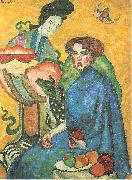 |
Mashkov, Ilya
|
|
Russian Painter, 1881-1944
was a Russian artist, one of the most significant and at the same time most characteristic painters of the circle of "Jack of Diamonds" He was born in the cossack village Mikhailovskaya-on-Don (near Volgograd) 29 July [O.S. 17 July] 1881 in a peasant family. After arriving at Moscow in 1900 he attended the Moscow School of Painting, Sculpture and Architecture, whose teachers included Konstantin Korovin and Valentin Serov. In 1909 he was expelled from the school because of his artistic free thinking. He traveled much as a student, visiting a number of the countries of West Europe, and also Turkey and Egypt. He was the member of associations "Mir iskusstva"
|
|
|
|
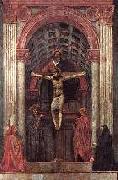 |
MASACCIO
|
|
Italian Early Renaissance Painter, 1401-1428
was the first great painter of the Quattrocento period of the Italian Renaissance. His frescoes are the earliest monuments of Humanism, and introduce a plasticity previously unseen in figure painting. The name Masaccio is a humorous version of Tommaso, meaning "big", "fat", "clumsy" or "messy" Tom. The name was created to distinguish him from his principal collaborator, also called Tommaso, who came to be known as Masolino ("little/delicate Tom"). Despite his brief career, he had a profound influence on other artists. He was one of the first to use scientific perspective in his painting, employing techniques such as vanishing point in art for the first time. He also moved away from the Gothic style and elaborate ornamentation of artists like Gentile da Fabriano to a more natural mode that employed perspective for greater realism. Masaccio was born to Giovanni di Mone Cassa??i and Jacopa di Martinozzo in Castel San Giovanni di Altura, now San Giovanni Valdarno (now part of the province of Arezzo, Tuscany). His father was a notary and his mother the daughter of an innkeeper of Barberino di Mugello, a town a few miles south of Florence. His family name, Cassai, comes from the trade of his grandfather Simone and granduncle Lorenzo, who were carpenters - cabinet makers ("casse", hence "cassai"). His father died in 1406, when Tommaso was only five; in that year another brother was born, called Giovanni after the dead father. He also was to become a painter, with the nickname of "Scheggia" meaning "splinter". The mother was remarried to an elderly apothecary, Tedesco, who guaranteed Masaccio and his family a comfortable childhood.
|
|
|
|
|
|
|
|
|
| Wholesale China Oil Painting Wholesale Oil Painting China Xiamen Portrait Reproduction on canvas Chinese Oil Painting Wholesale USA Oil Painting |
|
|
|
|
|